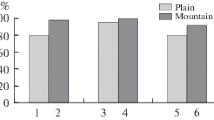Abstract
The biological activity of soil samples taken from genetic horizons of plowed and virgin chernozems in the Kamennaya Steppe Reserve was determined as the amount evolved from the soil upon its incubation in laboratory conditions. In the top humus horizons, the biological activity of virgin chernozem was two to three times higher as compared with that in the plowed chernozem. The intensity of biological processes and the microbial biomass in the soil profile was mainly controlled by the quantity and quality of soil organic matter. Long-term agricultural use exerted a weaker effect on the biological properties of chernozems developed on microelevations (blocks) of the paleocryogenic microtopography in comparison with chernozems developed in the microdepressions between the blocks. The factor analysis showed that soil characteristics related to the biological processes comprise more than 50% of the total variance of factor loads and are distinctly differentiated in the soil profile.
Similar content being viewed by others
References
V. M. Alifanov and L. A. Gugalinskaya, “Paleohydromorphism, Paleocryogenesis, and Morpholithopedogenesis of Chernozems,” Pochvovedenie, No. 3, 309–315 (2005) [Eur. Soil Sci. 38 (3), 272–277 (2005)].
V. M. Alifanov, L. A. Gugalinskaya, R. A. Antoshechkina, and E. A. Cherep’yanova, “Paleocryogenic Peculiarities of the Morphogenesis of Chernozems in the Kamennaya Steppe,” Pochvovedenie, No. 8, 909–917 (2001) [Eur. Soil Sci. 34 (8), 806–814 (2001)].
L. A. Gugalinskaya, L. A. Ivannikova, V. M. Alifanov, and N. A. Antoshechkina, “Pedocycliths in Gray Forest and Buried Bryansk Soils of the Vladimir Opol’e and Biological Methods of Their Diagnostics,” Pochvovedenie, No. 10, 1157–1169 (2001) [Eur. Soil Sci. 34 (10), 1031–1042 (2001)].
A. V. Golovchenko and L. M. Polyanskaya, “Seasonal Dynamics of Population and Biomass of Microorganisms in the Soil Profile,” Pochvovedenie, No. 10, 1227–1233 (1996) [Eur. Soil Sci. 29 (10), 1045–1050 (1996)].
G. V. Dobrovol’skii, “The Role of Soils in Preservation of Biodiversity,” Pochvovedenie, No. 6, 694–698 (1996) [Eur. Soil Sci. 29 (6), 626–629 (1996)].
G. A. Zavarzin, “Development of the Biosphere,” Mikrobiologiya 66(6), 725–734 (1997).
L. A. Ivannikova, RF Patent No. 1 806 375 (1992).
L. A. Ivannikova, “Procedure of Determining the Mineralization of Organic Matter in Soil from Production,” in Methods of Studying Soil Organic Matter (Vladimir, 2005), pp. 376–385 [in Russian].
L. M. Polyanskaya, V. V. Geidebrekht, A. L. Stepanov, and D. G. Zvyagintsev, “Distribution of Microbial Population and Biomass along the Profiles of Zonal Soils,” Pochvovedenie, No. 3, 322–328 (1995).
A. Agnelli, J. Ascher, G. Corti, et al., “Distribution of Microbial Communities in a Forest Soil Profile Investigated by Microbial Biomass, Soil Respiration, and DGGE of Total and Extracellular DNA,” Soil Biol. Biochem. 36(5), 859–868 (2004).
H. A. Ajwa, C. W. Pice, and D. Sotomayor, “Carbon and Nitrogen Mineralization in Tallgrass Prairie and Agricultural Soil Profiles,” Soil Sci. Soc. Am. J. 62, 942–951 (1998).
N. Fierer, J. P. Schimel, and P. A. Holden, “Variations in Microbial Community Composition through Two Soil Depth Profiles,” Soil Biol. Biochem. 35, 167–176 (2003).
A. J. Franzluebbers, “Potential C and N Mineralization and Microbial Biomass from Intact and Increasingly Disturbed Soils of Varying Texture,” Soil Biol. Biochem. 31, 1083–1090 (1999).
H. Fritze, J. Pietikainen, and T. Pennanen, “Distribution of Microbial Biomass and Phospholipids Fatty Acids in Podzol Profiles under Coniferous Forest,” Eur. J. Soil Sci. 51, 565–573 (2000).
P. R. Hargreaves, P. C. Brookes, G. J. S. Ross, and P. R. Poulton, “Evaluating Soil Microbial Biomass Carbon as an Indicator of Long-Term Environmental Change,” Soil Biol. Biochem. 35(3), 401–407 (2003).
D. S. Jenkinson and D. S. Powlson, “The Effects of Biocidal Treatments on Metabolism in Soil: V. A Method for Measuring Soil Biomass,” Soil Biol. Biochem. 8(3), 209–213 (1976).
B. A. Stevenson, G. P. Sparling, L. A. Schipper, et al., “Pasture and Forest Soil Microbial Communities Show Distinct Patterns in Their Catabolic Respiration Responses at a Landscape Scale,” Soil Biol. Biochem. 36(1), 49–55 (2004).
V. Wolters and R. G. Joergensen, “Microbial Carbon Turnover in Beech Forest Soils at Different Stages of Acidification,” Soil Biol. Biochem. 23, 897–902 (1991).
Author information
Authors and Affiliations
Rights and permissions
About this article
Cite this article
Ivannikova, L.A. Biological activity in the profiles of chernozems as dependent on the character of their agricultural use and microtopography. Eurasian Soil Sc. 39 (Suppl 1), S98–S105 (2006). https://doi.org/10.1134/S1064229306130163
Received:
Issue Date:
DOI: https://doi.org/10.1134/S1064229306130163



